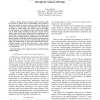Free Online Productivity Tools
i2Speak
i2Symbol
i2OCR
iTex2Img
iWeb2Print
iWeb2Shot
i2Type
iPdf2Split
iPdf2Merge
i2Bopomofo
i2Arabic
i2Style
i2Image
i2PDF
iLatex2Rtf
Sci2ools
WCRE
2009
IEEE
2009
IEEE
SQUAD: Software Quality Understanding through the Analysis of Design
—Object-oriented software quality models usually use metrics of classes and of relationships among classes to assess the quality of systems. However, software quality does not depend on classes solely: it also depends on the organisation of classes, i.e., their design. Our thesis is that it is possible to understand how the design of systems affects their quality and to build quality models that take into account various design styles, in particular design patterns, antipatterns, and code smells. To demonstrate our thesis, we first analyse how playing roles in design patterns, antipatterns, and code smells impacts quality; specifically change-proneness, fault-proneness, and maintenance costs. Second, we build quality models and apply and validate them on open-source and industrial objectoriented systems to show that they allow a more precise evaluation of the quality than traditional models, like Bansiya et al.’s QMOOD. Keywords-Design styles, change-proneness, fault-proneness, q...
| Added | 21 May 2010 |
| Updated | 21 May 2010 |
| Type | Conference |
| Year | 2009 |
| Where | WCRE |
| Authors | Foutse Khomh |
Comments (0)

